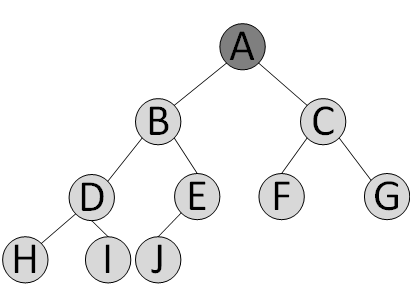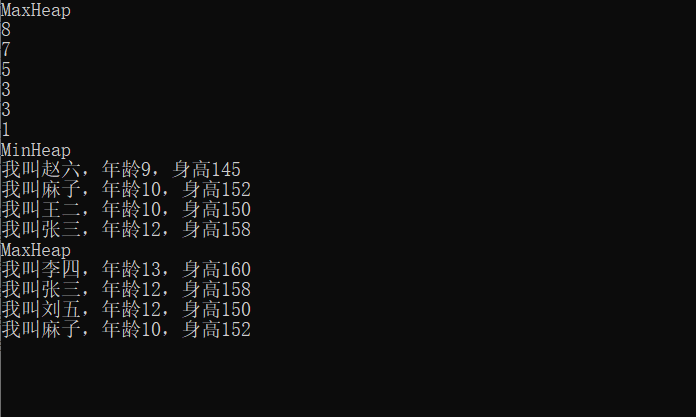您好,登录后才能下订单哦!
如何在C#项目中实现一个数据结构堆?相信很多没有经验的人对此束手无策,为此本文总结了问题出现的原因和解决方法,通过这篇文章希望你能解决这个问题。
堆是用来排序的,通常是一个可以被看做一棵树的数组对象。堆满足已下特性:
1. 堆中某个节点的值总是不大于或不小于其父节点的值
任意节点的值小于(或大于)它的所有后裔,所以最小元(或最大元)在堆的根节点上(堆序性)。堆有大根堆和小根堆,将根节点最大的堆叫做最大堆或大根堆,根节点最小的堆叫做最小堆或小根堆。
2. 堆总是一棵完全二叉树
除了最底层,其他层的节点都被元素填满,且最底层尽可能地从左到右填入。
堆示意图:

将堆元素从上往下从左到右放进数组对象中,子父节点索引满足关系:
parentIndex = (index+1)/ 2 - 1;
childLeftIndex = parentIndex * 2 + 1;
childRightIndex = (parentIndex + 1) * 2;
其中:index为任一节点索引;parentIndex该节点父索引;childLeftIndex该父节点下的子左节点;childRightIndex该父节点下的子右节点。
创建堆的大概思路:
1. 向堆中添加元素:
加到数组尾处,循环比对其父节点值(大根堆和小根堆比对策略不一样),比对结果的目标索引不是父节点索引则交换子父节点元素,继续向上比对其父父节点…;直至比对过程中目标索引为父节点索引或达到根节点结束,新堆创建完成。
2. 向堆中取出元素:
取出根节点元素,并将堆末尾元素插入根节点(为了保证堆的完全二叉树特性),从根部再循环向下比对父节点、子左节点、子右节点值,比对结果目标索引不为父节点交换目标索引和父节点的值,向下继续比对;直至比对过程中目标索引为父节点索引或达到堆尾部结束,新堆创建完成。
因为大根堆和小根堆只是比较策略不同,所以整合了两者,用的时候可以直接设置堆的类别;默认小根堆,默认比较器。实现代码如下:
public class Heap<T>
{
private T[] _array;//数组,存放堆数据
private int _count;//堆数据数量
private HeapType _typeName;//堆类型
private const int _DefaultCapacity = 4;//默认数组容量/最小容量
private const int _ShrinkThreshold = 50;//收缩阈值(百分比)
private const int _MinimumGrow = 4;//最小扩容量
private const int _GrowFactor = 200; // 数组扩容百分比,默认2倍
private IComparer<T> _comparer;//比较器
private Func<T, T, bool> _comparerFunc;//比较函数
//堆数据数量
public int Count => _count;
//堆类型
public HeapType TypeName => _typeName;
public Heap() : this(_DefaultCapacity, HeapType.MinHeap, null) { }
public Heap(int capacity) : this(capacity, HeapType.MinHeap, null) { }
public Heap(HeapType heapType) : this(_DefaultCapacity, heapType, null) { }
public Heap(int capacity, HeapType heapType, IComparer<T> comparer)
{
Init(capacity, heapType, comparer);
}
public Heap(IEnumerable<T> collection, HeapType heapType, IComparer<T> comparer)
{
if (collection == null)
throw new IndexOutOfRangeException();
Init(collection.Count(), heapType, comparer);
using (IEnumerator<T> en = collection.GetEnumerator())//避免T在GC堆中有非托管资源,GC不能释放,需手动
{
while (en.MoveNext())
Enqueue(en.Current);
}
}
private void Init(int capacity, HeapType heapType, IComparer<T> comparer)
{
if (capacity < 0)
throw new IndexOutOfRangeException();
_count = 0;
_array = new T[capacity];
_comparer = comparer ?? Comparer<T>.Default;
_typeName = heapType;
switch (heapType)
{
default:
case HeapType.MinHeap:
_comparerFunc = (T t1, T t2) => _comparer.Compare(t1, t2) > 0;//目标对象t2小
break;
case HeapType.MaxHeap:
_comparerFunc = (T t1, T t2) => _comparer.Compare(t1, t2) < 0;//目标对象t2大
break;
}
}
public T Dequeue()
{
if (_count == 0)
throw new InvalidOperationException();
T result = _array[0];
_array[0] = _array[--_count];
_array[_count] = default(T);
if (_array.Length > _DefaultCapacity && _count * 100 <= _array.Length * _ShrinkThreshold)//缩容
{
int newCapacity = Math.Max(_DefaultCapacity, (int)((long)_array.Length * (long)_ShrinkThreshold / 100));
SetCapacity(newCapacity);
}
AdjustHeap(_array, 0, _count);
return result;
}
public void Enqueue(T item)
{
if (_count >= _array.Length)//扩容
{
int newCapacity = Math.Max(_array.Length+_MinimumGrow, (int)((long)_array.Length * (long)_GrowFactor / 100));
SetCapacity(newCapacity);
}
_array[_count++] = item;
int parentIndex;
int targetIndex;
int targetCount = _count;
while (targetCount > 1)
{
parentIndex = targetCount / 2 - 1;
targetIndex = targetCount - 1;
if (!_comparerFunc.Invoke(_array[parentIndex], _array[targetIndex]))
break;
Swap(_array, parentIndex, targetIndex);
targetCount = parentIndex + 1;
}
}
private void AdjustHeap(T[] array, int parentIndex, int count)
{
if (_count < 2)
return;
int childLeftIndex = parentIndex * 2 + 1;
int childRightIndex = (parentIndex + 1) * 2;
int targetIndex = parentIndex;
if (childLeftIndex < count && _comparerFunc.Invoke(array[parentIndex], array[childLeftIndex]))
targetIndex = childLeftIndex;
if (childRightIndex < count && _comparerFunc.Invoke(array[targetIndex], array[childRightIndex]))
targetIndex = childRightIndex;
if (targetIndex != parentIndex)
{
Swap(_array, parentIndex, targetIndex);
AdjustHeap(_array, targetIndex, _count);
}
}
private void SetCapacity(int capacity)
{
T[] newArray = new T[capacity];
Array.Copy(_array, newArray, _count);
_array = newArray;
}
private void Swap(T[] array, int index1, int index2)
{
T temp = array[index1];
array[index1] = array[index2];
array[index2] = temp;
}
public void Clear()
{
Array.Clear(_array, 0, _count);
Init(_DefaultCapacity, HeapType.MinHeap, null);
}
}
public enum HeapType { MinHeap, MaxHeap }建一个Person类用来测试,例子中Person比较规则是:先按年龄比较,年龄相同再按身高比较。具体比较大小是由选择堆的类别进行不同的排序规则:如Person类中小根堆先按年龄小者排序,年龄相同者按身高大者排序;而使用大根堆则相反。两种比较器写法,前者直接使用默认比较器;后者需要将比较器注入到堆中。
public class Person : IComparable<Person>
{
public string name { get; set; }
public int Age { get; set; }
public int Height { get; set; }
public override string ToString()
{
return $"我叫{name},年龄{Age},身高{Height}";
}
//小根堆:先排年龄小,年龄相同,按身高大的先排;大根堆相反
public int CompareTo(Person other)
{
if (this.Age.CompareTo(other.Age) != 0)
return this.Age.CompareTo(other.Age);
else if (this.Height.CompareTo(other.Height) != 0)
return ~this.Height.CompareTo(other.Height);
else
return 0;
}
}
public class personComparer : IComparer<Person>
{
//大根堆:先排年龄大,年龄相同,按身高大的先排;小根堆相反
public int Compare(Person x, Person y)
{
if (x.Age.CompareTo(y.Age) != 0)
return x.Age.CompareTo(y.Age);
else if (x.Height.CompareTo(y.Height) != 0)
return x.Height.CompareTo(y.Height);
else
return 0;
}
}主函数调用:
static void Main(string[] args)
{
int[] array = { 3, 5, 8, 3, 7, 1 };
Heap<int> heap0 = new Heap<int>(array, HeapType.MaxHeap, null);
Console.WriteLine(heap0.TypeName);
Console.WriteLine(heap0.Dequeue());
Console.WriteLine(heap0.Dequeue());
Console.WriteLine(heap0.Dequeue());
Console.WriteLine(heap0.Dequeue());
int length = heap0.Count;
for (int count = 0; count < length; count++)
{
Console.WriteLine(heap0.Dequeue());
}
Person person1 = new Person() { Age = 12, Height = 158, name = "张三" };
Person person2 = new Person() { Age = 13, Height = 160, name = "李四" };
Person person3 = new Person() { Age = 10, Height = 150, name = "王二" };
Person person4 = new Person() { Age = 10, Height = 152, name = "麻子" };
Person person5 = new Person() { Age = 12, Height = 150, name = "刘五" };
List<Person> people = new List<Person>();
people.Add(person1);
people.Add(person2);
people.Add(person3);
people.Add(person4);
people.Add(person5);
Heap<Person> heap2 = new Heap<Person>(people, HeapType.MinHeap, null);
Person person6 = new Person() { Age = 9, Height = 145, name = "赵六" };
heap2.Enqueue(person6);
Console.WriteLine(heap2.TypeName);
Console.WriteLine(heap2.Dequeue());
Console.WriteLine(heap2.Dequeue());
Console.WriteLine(heap2.Dequeue());
Console.WriteLine(heap2.Dequeue());
PersonComparer personComparer = new PersonComparer();
Heap<Person> heap3 = new Heap<Person>(1,HeapType.MaxHeap,personComparer);
heap3.Enqueue(person1);
heap3.Enqueue(person2);
heap3.Enqueue(person3);
heap3.Enqueue(person4);
heap3.Enqueue(person5);
heap3.Enqueue(person6);
Console.WriteLine(heap3.TypeName);
Console.WriteLine(heap3.Dequeue());
Console.WriteLine(heap3.Dequeue());
Console.WriteLine(heap3.Dequeue());
Console.WriteLine(heap3.Dequeue());
Console.ReadKey();
}输出结果:

看完上述内容,你们掌握如何在C#项目中实现一个数据结构堆的方法了吗?如果还想学到更多技能或想了解更多相关内容,欢迎关注亿速云行业资讯频道,感谢各位的阅读!
免责声明:本站发布的内容(图片、视频和文字)以原创、转载和分享为主,文章观点不代表本网站立场,如果涉及侵权请联系站长邮箱:is@yisu.com进行举报,并提供相关证据,一经查实,将立刻删除涉嫌侵权内容。